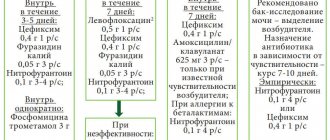Directions for use and doses
The dosage regimen is selected individually depending on the age and body weight of the patient. For adults, the initial dose is 600 mg/day, followed by an increase in dose by 200 mg every 3 days until the optimal effect is achieved. Frequency of administration: 1-2 times/day. The maximum recommended dose is 1-2 g/day. The tablets should be swallowed whole with a small amount of water. In elderly patients, the dosage regimen of Valparin XP is similar to the dosage regimen in adults and is selected individually. For children weighing more than 20 kg, the initial dose is 400 mg/day. The dose should be increased gradually until optimal values are reached - usually 20-30 mg/kg/day in 1 or 2 doses. Valparin XP should not be used in children weighing up to 20 kg.
VALPARINE HR
Interaction
combinations are contraindicated
:
the risk of epileptic seizures in patients with epilepsy due to increased metabolism of valproic acid and convulsant mefloquine.
St. John's wort:
the danger of reducing the concentration of valproic acid in the blood plasma.
Combinations not recommended
Lamotrigine:
increased risk of severe skin reactions up to the development of toxic epidermal necrolysis. In addition, the plasma concentration of lamotrigine increases (its metabolism in the liver is slowed down by valproic acid). If the combination is necessary, careful clinical and laboratory monitoring is required.
Combinations requiring special precautions
Carbamazepine:
an increase in the concentration of the active metabolite of carbamazepine in plasma with signs of overdose. In addition, a decrease in the concentration of valproic acid in plasma is associated with increased metabolism of valproic acid in the liver under the influence of carbamazepine. Recommended: clinical observation, determination of drug concentrations in plasma and, possibly, dose adjustment, especially at the beginning of treatment.
Carbapenems, monobactams:
meropenem, panipenem, and, by extrapolation, aztreonam and imipenem: an increased risk of seizures due to a decrease in the concentration of valproic acid in the blood plasma. Recommended: clinical observation, determination of drug concentrations in blood plasma; dose adjustment of valproic acid may be required during treatment with an antibacterial agent and after its discontinuation.
Felbamat:
increased concentration of valproic acid in blood plasma with the risk of overdose. Recommended: clinical and laboratory monitoring and possible dose revision of valproic acid during treatment with felbamate and after its discontinuation).
Phenobarbital, primidone
: increased plasma concentrations of phenobarbital and primidone with signs of overdose, usually in children. In addition, a decrease in the concentration of valproic acid in plasma associated with increased hepatic metabolism under the influence of phenobarbital or primidone. Recommended: clinical monitoring during the first 15 days of combination treatment with immediate reduction of the dose of phenobarbital or primidone at the first signs of sedation, determination of blood concentrations of both anticonvulsants.
Phenytoin:
changes in the concentration of phenytoin in plasma, the risk of a decrease in the concentration of valproic acid associated with increased metabolism of valproic acid in the liver under the influence of phenytoin. Recommended: clinical monitoring with determination of plasma concentrations of both antiepileptic drugs and, if necessary, adjustment of their doses.
Topiramate
: risk of developing hyperammonemia or encephalopathy. Recommended: clinical and laboratory monitoring during the first month of treatment and in case of symptoms of ammonemia.
Neuroleptics, monoamine oxidase inhibitors (MAOIs), antidepressants, benzodiazepines
: valproic acid potentiates the effect of psychotropic drugs such as antipsychotics, MAO inhibitors, antidepressants, benzodiazepines. Recommended: clinical monitoring and, if necessary, dose adjustment of the drug.
Cimetidine and erythromycin:
the concentration of valproic acid in the blood plasma increases.
Zidovudine
: Valproic acid may increase plasma concentrations of zidovudine, resulting in increased zidovudine toxicity.
Combinations to Consider
Nimodipine (orally and, by extrapolation, parenterally)
: increased hypotensive effect of nimodipine due to a decrease in its metabolism under the influence of valproic acid and an increase in plasma concentration.
Acetylsalicylic acid
: increased effects of valproic acid due to an increase in its concentration in the blood plasma.
When used simultaneously with anticoagulants, vitamin K antagonists require careful monitoring of the prothrombin index.
Other forms of interaction
Valproic acid does not have an enzyme-inducing effect and therefore does not affect the effectiveness of hormonal contraceptives containing combinations of estrogen and progesterone
.
special instructions
It is necessary to regularly monitor the activity of transaminases, bilirubin content, blood platelets, amylase (every 3 months). Valproic acid inhibits platelet aggregation, which increases the risk of increasing blood clotting time during bleeding. The possibility of complications associated with bleeding in the postoperative period should be taken into account in patients receiving sodium valproate. With long-term use of sodium valproate, spontaneous hematomas and bleeding may develop. In this case, you should immediately stop taking the drug. Sodium valproate can cause drug-induced pancreatitis and liver dysfunction (usually in the first 6 months of use). In this regard, during the first 23 months of treatment it is necessary to monitor the condition of the pancreas, perform liver tests, and monitor the level of prothrombin. Impaired liver function and liver failure during therapy with sodium valproate are sometimes observed in children with epilepsy and combined metabolic and degenerative diseases, organic pathology of brain tissue and delayed mental development. If symptoms such as severe weakness, lethargy, swelling, vomiting and jaundice occur, you should immediately stop using the drug. Impact on the ability to drive vehicles and operate machinery. The patient should be careful when working with mechanisms, because the drug reduces the ability to concentrate.
Valparin hr tab p/o film prolong. 300 mg 100 pcs
Contraindicated combinations Mefloquine: risk of epileptic seizures in patients with epilepsy due to increased metabolism of valproic acid and convulsant mefloquine.
St. John's wort: danger of reducing the concentration of valproic acid in the blood plasma.
Combinations not recommended
Lamotrigine: increased risk of severe skin reactions including toxic epidermal necrolysis. In addition, the plasma concentration of lamotrigine increases (its metabolism in the liver is slowed down by valproic acid). If the combination is necessary, careful clinical and laboratory monitoring is required.
Combinations requiring special precautions
Carbamazepine: increased concentration of the active metabolite of carbamazepine in plasma with signs of overdose. In addition, a decrease in the concentration of valproic acid in plasma is associated with increased metabolism of valproic acid in the liver under the influence of carbamazepine. Recommended: clinical observation, determination of drug concentrations in plasma and, possibly, dose adjustment, especially at the beginning of treatment.
Carbapenems, monobactams: meropenem, panipenem, and, by extrapolation, aztreonam and imipenem: increased risk of seizures due to a decrease in the concentration of valproic acid in the blood plasma. Recommended: clinical observation, determination of drug concentrations in blood plasma; dose adjustment of valproic acid may be required during treatment with an antibacterial agent and after its discontinuation.
Felbamate: increased plasma concentrations of valproic acid with the risk of overdose. Recommended: clinical and laboratory monitoring and possible dose revision of valproic acid during treatment with felbamate and after its discontinuation).
Phenobarbital, primidone: increased plasma concentrations of phenobarbital and primidone with signs of overdose, usually in children. In addition, a decrease in the concentration of valproic acid in plasma associated with increased hepatic metabolism under the influence of phenobarbital or primidone. Recommended: clinical monitoring during the first 15 days of combination treatment with immediate reduction of the dose of phenobarbital or primidone at the first signs of sedation, determination of blood concentrations of both anticonvulsants.
Phenytoin: changes in the concentration of phenytoin in plasma, the risk of a decrease in the concentration of valproic acid associated with increased metabolism of valproic acid in the liver under the influence of phenytoin. Recommended: clinical monitoring with determination of plasma concentrations of both antiepileptic drugs and, if necessary, adjustment of their doses.
Topiramate: Risk of hyperammonemia or encephalopathy. Recommended: clinical and laboratory monitoring during the first month of treatment and in case of symptoms of ammonemia.
Neuroleptics, monoamine oxidase inhibitors (MAO inhibitors), antidepressants, benzodiazepines: Valproic acid potentiates the effect of psychotropic drugs such as neuroleptics, MAO inhibitors, antidepressants, benzodiazepines. Recommended: clinical monitoring and, if necessary, dose adjustment of the drug.
Cimetidine and erythromycin: the concentration of valproic acid in the blood plasma increases.
Zidovudine: Valproic acid may increase plasma concentrations of zidovudine, resulting in increased zidovudine toxicity.
Combinations to Consider
Nimodipine (oral and, by extrapolation, parenteral): increased hypotensive effect of nimodipine due to a decrease in its metabolism under the influence of valproic acid and increased concentration in the blood plasma.
Acetylsalicylic acid: increased effects of valproic acid due to an increase in its concentration in the blood plasma.
When used concomitantly with anticoagulants, vitamin K antagonists require careful monitoring of the prothrombin index.
Other forms of interaction
Valproic acid does not have an enzyme-inducing effect and therefore does not affect the effectiveness of hormonal contraceptives containing combinations of estrogen and progesterone.
Valparin hr tab p/o film prolong. 500 mg 100 pcs
Contraindicated combinations Mefloquine: risk of epileptic seizures in patients with epilepsy due to increased metabolism of valproic acid and convulsant mefloquine.
St. John's wort: danger of reducing the concentration of valproic acid in the blood plasma.
Combinations not recommended
Lamotrigine: increased risk of severe skin reactions including toxic epidermal necrolysis. In addition, the plasma concentration of lamotrigine increases (its metabolism in the liver is slowed down by valproic acid). If the combination is necessary, careful clinical and laboratory monitoring is required.
Combinations requiring special precautions
Carbamazepine: increased concentration of the active metabolite of carbamazepine in plasma with signs of overdose. In addition, a decrease in the concentration of valproic acid in plasma is associated with increased metabolism of valproic acid in the liver under the influence of carbamazepine. Recommended: clinical observation, determination of drug concentrations in plasma and, possibly, dose adjustment, especially at the beginning of treatment.
Carbapenems, monobactams: meropenem, panipenem, and, by extrapolation, aztreonam and imipenem: increased risk of seizures due to a decrease in the concentration of valproic acid in the blood plasma. Recommended: clinical observation, determination of drug concentrations in blood plasma; dose adjustment of valproic acid may be required during treatment with an antibacterial agent and after its discontinuation.
Felbamate: increased plasma concentrations of valproic acid with the risk of overdose. Recommended: clinical and laboratory monitoring and possible dose revision of valproic acid during treatment with felbamate and after its discontinuation).
Phenobarbital, primidone: increased plasma concentrations of phenobarbital and primidone with signs of overdose, usually in children. In addition, a decrease in the concentration of valproic acid in plasma associated with increased hepatic metabolism under the influence of phenobarbital or primidone. Recommended: clinical monitoring during the first 15 days of combination treatment with immediate reduction of the dose of phenobarbital or primidone at the first signs of sedation, determination of blood concentrations of both anticonvulsants.
Phenytoin: changes in the concentration of phenytoin in plasma, the risk of a decrease in the concentration of valproic acid associated with increased metabolism of valproic acid in the liver under the influence of phenytoin. Recommended: clinical monitoring with determination of plasma concentrations of both antiepileptic drugs and, if necessary, adjustment of their doses.
Topiramate: Risk of hyperammonemia or encephalopathy. Recommended: clinical and laboratory monitoring during the first month of treatment and in case of symptoms of ammonemia.
Neuroleptics, monoamine oxidase inhibitors (MAO inhibitors), antidepressants, benzodiazepines: Valproic acid potentiates the effect of psychotropic drugs such as neuroleptics, MAO inhibitors, antidepressants, benzodiazepines. Recommended: clinical monitoring and, if necessary, dose adjustment of the drug.
Cimetidine and erythromycin: the concentration of valproic acid in the blood plasma increases.
Zidovudine: Valproic acid may increase plasma concentrations of zidovudine, resulting in increased zidovudine toxicity.
Combinations to Consider
Nimodipine (oral and, by extrapolation, parenteral): increased hypotensive effect of nimodipine due to a decrease in its metabolism under the influence of valproic acid and increased concentration in the blood plasma.
Acetylsalicylic acid: increased effects of valproic acid due to an increase in its concentration in the blood plasma.
When used concomitantly with anticoagulants, vitamin K antagonists require careful monitoring of the prothrombin index.
Other forms of interaction
Valproic acid does not have an enzyme-inducing effect and therefore does not affect the effectiveness of hormonal contraceptives containing combinations of estrogen and progesterone.






